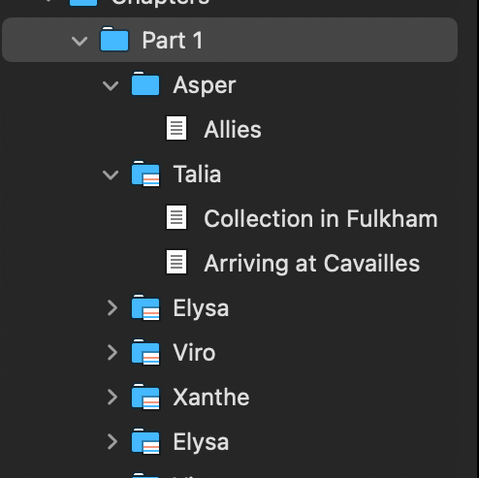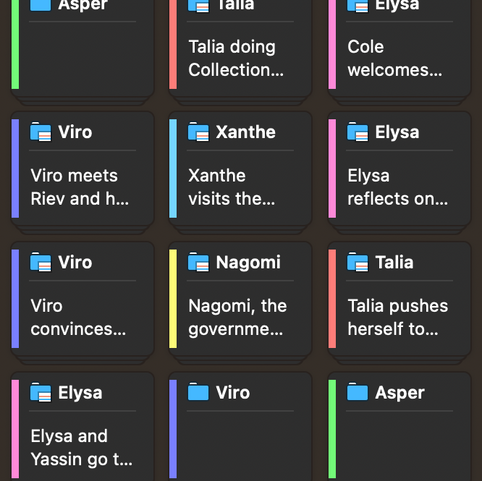The Magic of Scrivener
- A. M. Spaulding

- Feb 1, 2024
- 6 min read
“There is nothing to writing. All you do is sit down at a typewriter and bleed.“ - Ernest Hemingway
When I first started writing, I was using a notes app on my iPad. I had different notes for scenes and characters and, quite frankly, it was a jumbled mess.
There is no way that those haphazard entries would ever have turned into a novel. Working with a large scope project like a book means you have to have some semblance of order. You have background information, research, character sheets, setting descriptions, maps, old chapters, random lines that came to you at 2am that you are determined to fit into the narrative.
Oh, and then you have 100,000 words (or more!) of mansucript which, when you get to the editing phase, starts to get chopped, moved, and spliced like a word salad.
It's a daunting task to manage.
But I was NOT thinking ahead on this front. I was in between jobs and was too busy filling my time with creative bursts of writing (mostly angry scenes directed at my past employer) to think about whether my process was working.
I have to give credit where credit's due -- it was my husband who came to me and said: "You should use Scrivener for your writing."
That was it. Casual. Laconic. An offhand remark of an introverted product manager who spends a lot of time on the internet and therefore knows a multitude of random things. Including, apparently, a writing program for authors.
And it changed my life.
Scrivener
It took me all of one day before I had downloaded Scrivener. I realized immediately after his suggestion that writing in a notes app was not sustainable. I also realized that this was something I wanted to actually do. I wasn't just writing to fill the summer before going to work at my new job at an elementary school. I wanted to write this damn thing. I wanted to write a book.
And that meant I needed a better system.
The program itself was a bit daunting to start. I'll admit, I was so excited to get my chapters in the system and continue writing that I didn't do a lot of research on how to actually usei Scrivener. Most of it was intuitive, a few things were looked up along the way, and some things just took a little trial and error.
Over the past five years, I've used Scrivener for a total of three projects. It is the reason that I finished my first manuscript SPELL WEAVER and it helped me immensely during the drafting of PROJECT GOD HUNTER, my current project, that I finished in six months.
So what do I love about Scrivener? Let me count the ways:
Feature #1: The Binder
The binder is your bread and butter in Scrivener. It's not really a feature per se, just the main UI of the program.
There are two main ways you can organize your manuscript:
Scenes as Chapters
Folders as Chapters
I've done both and I think it really just depends on your style. For SPELL WEAVER, my chapters sometimes had multiple scenes from the same character's point of view, lending itself easily to the Folders organization. For PROJECT GOD HUNTER, each scene was a chapter, so I just kept it simple.
You can have also use folders for different Parts of your story like I did above.

The binder also lets you keep all your project materials in one place, easily visible while drafting. Writing a novel requires so much more than just the manuscript text. It includes research documents, character profiles, notes, and various drafts. The binder was especially helpful as a fantasy author, world-building documents are basically another manuscript.
(You bet I needed to have a fully-fleshed out religion complete with doctrine and ritual descriptions.)
Overall, it's important to get familiar with your binder. Organize your manuscript and your research materials for easy drafting. Plus, it's fully customizable so you can set up folders and change icons to suit your fancy.
Feature #2: Split Screen
This is definitely my favorite feature!
Have you ever been writing furiously only to stop and think Wait, what was this character wearing? or How far away is this city from the river? or (most important of all) What color eyes did this character have?
(I will die on the eye-description hill)
In Scrivener, writers can split the editor into two panes, allowing them to view and edit different sections of their work simultaneously. This is especially useful for referencing notes or other chapters.

Personally, I always write in split screen. My current chapter is on the right and then I can navigate to different chapters and different notes in the binder based on what I need to know. Above, you can see my list of locations in the city of Nocturne and a little sneak peek of the current first page of PROJECT GOD HUNTER.
Feature #3: Word Count Targets

This one is pretty self-explanatory. Not all chapters are the same length, but it helps me to have a general target when I'm writing just to get an idea of how the scene will fit into the narrative.
At the bottom right of every new scene, you can click on the little target symbol to set a word count target. Then, as you write, the little blue bar fills up. It turns green when you are at or above your word count target, and the goal-oriented type-A person inside me just bursts with joy every time it happens.
Feature #4: Corkboard View
Scrivener's corkboard feature is a great way to organize ideas and scenes visually. Especially if you use labels to color code scenes based on character point-of-view, location, or timeline.
Each scene/folder will become a virtual index card which can be viewed at a glance. You can also move them around to rearrange the structure if you are editing (see below on the left).
You can also change the view to view each chapter arranged by label which is another cool way to visualize the progression in your manuscript (see below on the right).
Feature #5: Manuscript Overview
This is the master view. The one you pull up when you are panicking and wonder if you can actually write a novel after all. If you are a plotter, you might have your outline mapped out in empty chapters, scenes waiting to be filled. If you are a pantser, you might be adding as you go, growing your manuscript one scene at a time.
Either way, this is the perfect way to see your manuscript at a glance. You can easily scan chapter titles, chapter labels, current status (in progress, first draft, revised draft), total words, and progress towards target word count.

Nothing is Perfect:
Scrivener is amazing. It has great features for authors and I honestly find it pretty intuitive.
But alas, it's not perfect. Here are some of the things I wish it did better:
Compiling: Exporting your manuscript is just not intuitive at all. The presets are not great (why do they insist on using # in between paragraphs) and I am constantly struggling to choose the chapters I want or the format I want. Eventually, I figure it out. But it's never fast or easy.
Self-Editing: First off, I want track changes. Is that too much to ask? Yes, I can make comments on the side, but I cannot simply go through the document and correct things like I would in MS Word.
Collaboration: And on that note -- it's super hard to collaborate with others for editing. MS Word is still the professional standard and Google Docs is very popular among beta readers. However, there is no way to get those edits into Scrivener without manually inputting the comment or editing split screen with the other document open.
Syncing: The last time I checked, Scrivener synced between devices via Dropbox. That meant that you could technically write on two different laptops and have them stay up to date. However, it had (has?) horrible reviews about this process. The syncing doesn't work well between Mac and PC and doesn't do great between iOS and MacOS systems (e.g., between an ipad and laptop). This means you really need to have a dedicated device that you use. Or you need to write in some other program and transfer (e.g., in Google Docs, notes app, etc)
Final Thoughts:
If you are a writer and aren't happy with your system, I strongly suggest you give Scrivener a try. There is a free trial, but the full version is about $60 which is really rather reasonable.
And just for the record, I get absolutely nothing for recommending Scrivener. This isn't an ad. I just really love it and want to spread the word to help other writers.
If you are interested in seeing more of my writing journey or learning some insider details about PROJECT GOD HUNTER, follow me over on Instagram @aspauldingauthor.














Comments